Telangana TSBIE TS Inter 1st Year Environmental Education Study Material 17th Lesson Pollution Control Textbook Questions and Answers.
TS Inter 1st Year Environmental Education Study Material 17th Pollution Control
Essay Questions
Question 1.
Describe Air pollution control.
Answer:
A number of pollution control technologies have been developed. Pollution is regulated by various environmental agencies that establish limits for the discharge of pollutants. As the cost of pollution control may be prohibitive, attention was drawn towards reuse and recovery of value added products in the design of industrial processes with the objective of eliminating harmful environmental effects while promoting the competitiveness of industries.
Air Pollution Control :
The sources of air pollution include the burning of wood, charcoal and other biomass fuel, industries and vehicles. Air pollution control methodologies includes control of particulate emissions and the control of gaseous emissions. The term ‘particulate’ refers to tiny particles of matter such as smoke, soot and dust that are released during industrial, agricultural, or other activities. Gaseous emissions include sulphur dioxide, carbon monoxide and oxides of nitrogen.
Particulate control :
Particulate matter emitted from industrial sources is controlled through cyclone separators, fabric filter collectors, wet scrubbers, and electrostatic precipitators.
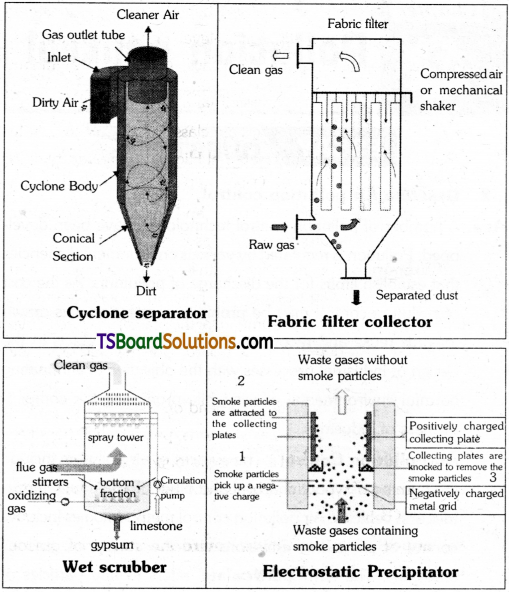
Particulate matter controlling equipment
a) Cyclone separators use centrifugal forces for separating particulates from stack gases. When the stack gas is fed into the cyclone separator, centrifugal forces cause particulates in the gas to move outwards against the walls of the container. Then the particulate matter falls to the bottom of the container and the gases escape from the top of the container.
b) Fabric Filters are used for removing particles from the gas stream by collecting smaller particles on the surface of filter bags. The larger particles drop out into the hopper. Clean gas passes through the filter media.
c) Wet scrubber are used for collecting both particulate matter and gases from industrial emissions by using scrubbing liquid for the same. Generally water is used for collecting particulate matter.
d) Electrostatic precipitators work by applying a high voltage to create an electrical field which ionizes the particulate matter in the gas around the discharge wires. When the gas that contains particulate matter flows between the collecting plates and the discharge wires, the aerosol particles in the gas are charged and collected on the collecting plates.
Gaseous emissions control :
Scrubbers that contain a moist chemical such as lime, magnesium oxide or sodium hydroxide are used for the control of unwanted gases from industrial stacks. When the gases escape from a factory and pass through a scrubber, they react with the moist chemical and are removed. Activated charcoal is also used to absorb the unwanted gases from industrial emissions.
Vehicular pollution control :
Using of unleaded petrol, low sulphur diesel and alternative fuels such as CNG, LPG, Hydrogen, Battery driven and Biodiesel can reduce pollution from vehicles.
Vehicular emission control methods include air injection, exhaust gas recirculation and using of a catalytic converter.
a) Air injection into the engine’s exhaust ports provides oxygen, so unbumed and partially burned hydrocarbons in the exhaust will finish burning.
b) Exhaust gas recirculation dilutes the air/fuel charge to reduce peak combustion chamber temperatures. This, in turn, reduces the formation of NOx (oxides of nitrogen).
c) Catalytic converters are placed in the exhaust pipe. Hydrocarbons, carbon monoxide and NOx are converted into less harmful gases by the use of a combination of platinum, palladium and rhodium as catalysts.
![]()
Question 2.
Describe water pollution control.
Answer:
Water Pollution Control :
Domestic sewage, industrial effluents and agricultural fields are the main sources of water pollution. Large-scale water and waste water treatment is typically carried out by municipalities and industries.
Sewage waste water contains carbohydrates, fats, proteins, metals, salts, pathogens and sediments. The characteristics of industrial waste water vary greatly in composition from industry to industry and may be highly acidic or alkaline and may also, contain soluble toxic organics, suspended solids, trace organics, heavy metals, cyanide, sulphides, oil and floating material.
Waste water treatment processes can be classified into physical, chemical or biological treatments. One or more of the following methods may be employed to achieve the treatment:
| GENERAL CLASSIFICATION OF WASTE WATER TREATMENT PROCESSES | ||
| Physical Operations | Chemical Processes | Biological Processes |
| Flow measurement Screening/grit removal Mixing Flocculation Sedimentation Flotation Filtration Drying Distillation Centrifuging Freezing Reverse osmosis |
Precipitation Neutralization Disinfection Chemical oxidation Chemical reduction Incineration Ion exchange Electrodialysis |
Aerobic action Anaerobic action Adsorption Aerobic- anaerobic combinations |
Sewage treatment :
Sewage is the waste water from households. It needs to be treated for the removal of contaminants. The treatment requires physical, chemical and biological processes which remove physical, chemical and biological contaminants in order to achieve an environmentally safe fluid waste stream.
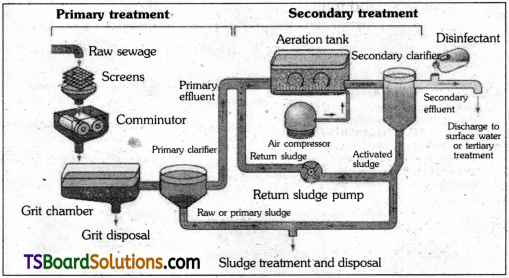
Question 3.
Write an essay on Solid Waste Management (SWM).
Answer:
Municipal Solid Waste Management : (MSWM) :
Accumulation of municipal solid wastes in urban areas is posing environmental hazards. The disposal of MSW is a challenge for India.
Integrated Solid Waste Management (ISWM) aims to reduce the amount of waste being disposed, while maximizing resource recovery and efficiency. The preferred waste management strategies include : Source reduction and reuse, recycling, waste to composting, waste to energy and finally waste disposal in landfill.
![]()
i) Source reduction and reuse :
The most preferred option for waste management is to prevent the generation of waste at various stages including at product design stage, production, packaging, use and reuse stages of a product.
ii) Waste recycling :
Segregation of recyclables and sending them for recycling.
iii) Waste to composting :
The organic fraction of waste can be composted through microbial or vermi composting.
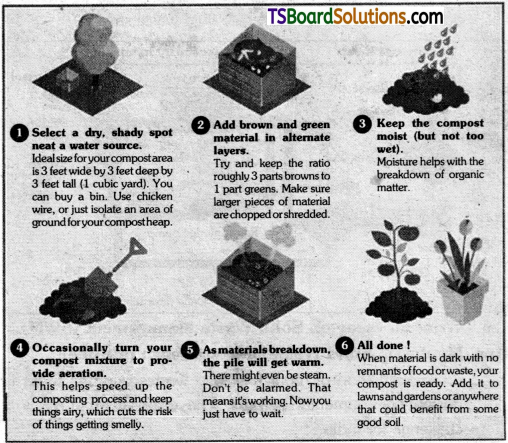
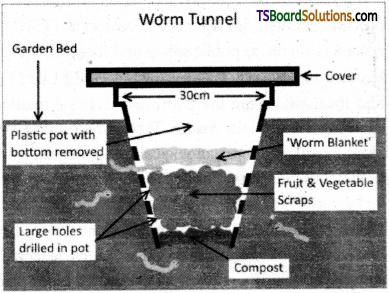
iv) Waste to Energy :
When material recovery is not possible, energy from waste (Efw) can be recovered through bio- methanation, waste incineration, production of Refuse Derived Fuel (RDF) and co-processing of the sorted dry rejects from MSW in cement kilns.
v) Waste Disposal :
Inerts (A category of waste that includes concrete, asphalt, brick, rubble and soil) need to be disposed in sanitary landfills, which are constructed in accordance with the regulations of the MSW Management and Handling Rules.
Hazardous Waste Management :
Any waste which exhibits ignitability, corrosivity, reactivity and toxicity, is combustible or has a flash point less than 60°C (140°F) is considered as a hazardous substance. Hazardous wastes are generated from petrochemical drug and metallurgical industries.
Household hazardous waste includes cleaners, stain removers, varnishes, batteries, automotive fluids, pesticides herbicides and certain paints.
Hazardous waste generated requires transport to an approved treatment, storage or disposal facility (TSDF) due to the potential threats to public safety and the environment.
Hazardous Waste Treatment :
Secured Land Fill disposal and incineration are the two main disposal methods for the disposal of hazardous wastes. Types of hazardous waste treatment include physical, biological and chemical neutralization or stabilization. Some treated hazardous wastes can even be reclaimed or recycled.
Secure landfills :
A secure landfill has two impermeable liners and leachate collection systems. The double leachate collection system consists of a network of perforated pipes placed above each liner. The upper system prevents the accumulation of leachate trapped in the fill and the lower layer acts as a backup. Collected leachate is pumped to a treatment plant. To reduce the amount of leachate and to minimize the potential for environmental damage, an impermeable cap or cover is placed over a finished landfill.
![]()
Question 4.
Write about Biomedical waste management, E-waste management and Radio active waste Management.
Answer:
Biomedical Waste Management :
Biomedical waste refers to waste generated during the diagnosis, treatment or immunization of human beings or animals, or in research activities. It is generated by clinics, ‘ hospitals and pathological laboratories. It requires treatment to reduce adverse effects due to the infectious nature of the waste. Without treatment it may spread infectious diseases like tuberculosis, hepatitis, enteric fever, HIV infection or even AIDS.
A common biomedical waste treatment facility (CBWTF) is used by several hospitals as individual treatment facility for small hospitals is not cost effective.
Segregation of biomedical waste is necessary as different types of treatment are required for different category of wastes. The relevant treatment methods are Incineration, Autoclaving, Shredding and Disposal.
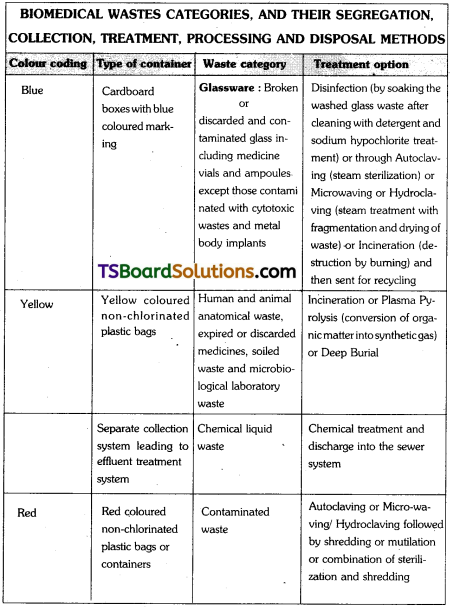

E-Waste Management :
Discarded electrical and electronic goods are considered as e-waste. Most electronic goods contain hazardous constituents. For example, cathode ray tubes (CRTs) of computer monitors contain heavy metals such as lead barium and cadmium, which can be very toxic to human health if they enter the water system. Flame-retardant plastics, used in electronics casings, release particles that can damage human endocrine functions.
Discarded electronic items are dismantled by hand and batteries are separated. The items are shredded into pieces to prepare the e-waste for sorting. Steel and iron are removed from the debris through magnets. Aluminum, copper, and brass are separated from the non-metallic content. The metals can then be reused and resold as raw materials. Water is used to separate plastic from the glass content. The sorted materials can be reused.
![]()
Radioactive Waste Management :
Radioactive wastes are generated from nuclear reactors, nuclear medicine and the manufacture of nuclear weapons. Depending on the waste source, radioactivity may last from a few hours to thousands of years. Disposal of radioactive wastes requires pre-treatment and storage in shielded containers. The containers are buried about 500m deep below the Earth’s surface.